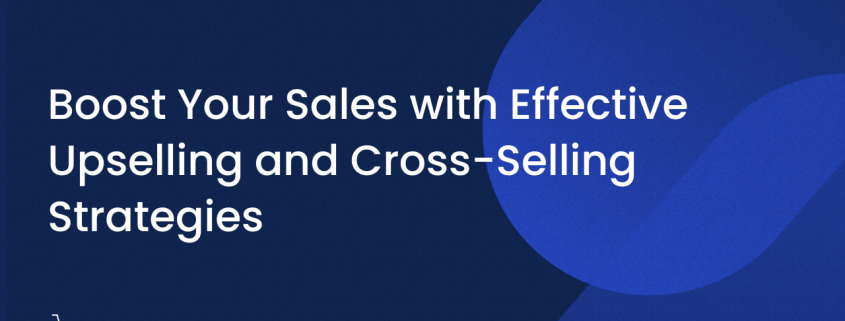Boost Your Sales with Effective Upselling and Cross-Selling Strategies
Introduction
Upselling and cross-selling are two powerful techniques that businesses employ to maximize their revenue potential. Upselling involves persuading customers to purchase a higher-priced product or service, while cross-selling encourages customers to buy related or complementary items. By employing these strategies effectively, businesses can not only increase sales but also enhance customer satisfaction and loyalty.
In this article, we will delve into the world of upselling and cross-selling, exploring their benefits, techniques, and best practices. We will also discuss the importance of customer-centricity and personalization in driving successful upselling and cross-selling campaigns.
Why Upselling and Cross-Selling Matter
Upselling and cross-selling present incredible opportunities for businesses to capitalize on existing customer relationships. Here’s why they matter:
1. Increased revenue: By encouraging customers to upgrade or purchase additional items, businesses can boost their average order value and generate more revenue.
2. Enhanced customer satisfaction: Upselling and cross-selling allow customers to discover products or services that better meet their needs, leading to greater satisfaction and long-term loyalty.
3. Deeper customer relationships: By understanding customers’ preferences and providing personalized recommendations, businesses can build stronger connections and trust.
4. Competitive advantage: Effective upselling and cross-selling strategies differentiate businesses from competitors, enabling them to stand out in the market.
The Art of Upselling: Techniques and Tips
Upselling is a powerful sales technique that focuses on encouraging customers to upgrade to a higher-priced option. Here are some effective techniques and tips to master the art of upselling:
1. Understand Your Customers’ Needs
To upsell successfully, you must have a deep understanding of your customers’ needs and pain points. By knowing what they value and what problems they seek to solve, you can identify opportunities to offer them a higher-priced solution that better meets their requirements.
2. Offer Value-Added Benefits
When upselling, it is essential to highlight the added value customers will receive by choosing the higher-priced option. Clearly communicate the benefits, features, and advantages that come with the upgrade, emphasizing how it aligns with their goals and preferences.
3. Personalize Recommendations
Tailor your upselling recommendations based on customers’ previous purchases, preferences, and browsing behaviour. Leverage data and insights to provide personalized suggestions, demonstrating that you genuinely understand their needs and can offer tailored solutions.
4. Provide Social Proof
Utilize social proof, such as customer testimonials, reviews, or case studies, to build trust and credibility. When customers see positive experiences from others who have chosen the upsell option, they are more likely to feel confident in their decision.
5. Offer Limited-Time Promotions
Create a sense of urgency by providing limited-time promotions or exclusive discounts for the higher-priced option. By emphasizing the time-sensitive nature of the offer, you can instill a fear of missing out, motivating customers to take action.
The Power of Cross-Selling: Strategies and Best Practices
Cross-selling involves recommending complementary products or services to customers. Here are some powerful strategies and best practices to make cross-selling work for your business:
1. Identify Complementary Products
To effectively cross-sell, it is crucial to identify products or services that naturally complement the customer’s initial purchase. Look for items that enhance the functionality, usability, or overall experience of the primary product. By offering relevant and valuable suggestions, you increase the chances of customers making additional purchases.
2. Utilize Data and Analytics
Leverage customer data and analytics to gain insights into buying patterns and preferences. By analyzing past purchase histories and behaviour, you can identify cross-selling opportunities that are highly likely to resonate with customers. Use this information to create targeted and personalized recommendations.
3. Strategic Product Placement
Ensure that cross-selling suggestions are prominently displayed during the customer’s purchasing journey. This can be done through well-designed product displays, intelligent product bundling, or personalized recommendations based on the customer’s browsing history. By strategically placing cross-selling options, you increase their visibility and the likelihood of conversion.
4. Bundle Offers and Packages
Create attractive bundles or package deals that combine the initial product with complementary items. This not only adds value to the customer but also simplifies their decision-making process. Clearly communicate the benefits of the bundle, such as cost savings or enhanced functionality, to entice customers to make the additional purchase.
5. Follow-Up Communication
Don’t miss the opportunity to cross-sell after the initial purchase. Implement a post-purchase follow-up strategy that includes personalized recommendations for related products or services. This could be through targeted email campaigns, personalized product suggestions on the website, or even a personalized thank-you note that includes cross-selling options.
The Role of Customer-Centricity and Personalization in Upselling and Cross-Selling
To truly unlock the potential of upselling and cross-selling, businesses must adopt a customer-centric approach and prioritize personalization. Here’s why it matters:
1. Build Trust and Relationships
By demonstrating a deep understanding of your customers’ needs and preferences, you build trust and foster long-lasting relationships. Customers feel valued when they receive personalized recommendations that align with their interests and requirements.
2. Increase Customer Satisfaction
When customers are presented with relevant upselling and cross-selling options, they feel that the business truly cares about their success. This leads to increased customer satisfaction, as they perceive the additional recommendations as valuable and beneficial.
3. Drive Repeat Business and Referrals
Satisfied customers are more likely to become repeat buyers and advocates for your brand. When they have positive experiences with upselling and cross-selling, they are more inclined to recommend your products or services to others, driving organic growth and new customer acquisition.
4. Adapt and Evolve with Customer Needs
By consistently analyzing customer data and feedback, businesses can adapt their upselling and cross-selling strategies to meet evolving customer needs. Personalization allows for dynamic adjustments, ensuring that recommendations remain relevant and impactful.
FAQs about Upselling and Cross-Selling
Is upselling the same as raising prices?
No, upselling involves offering customers a higher-priced option with added value and benefits. It focuses on providing a better solution that aligns with their needs and goals.
How can I avoid being pushy when upselling or cross-selling?
Avoid being overly aggressive or pushy by maintaining a customer-centric approach. Listen to customers, understand their requirements, and provide genuine recommendations that add value to their experience.
Are there any risks of implementing upselling and cross-selling strategies?
While upselling and cross-selling can be highly effective, businesses should be mindful of customer preferences and avoid overwhelming them with too many recommendations. Strive for balance and relevance to ensure a positive customer experience.
Conclusion: Master the Art of Upselling and Cross-Selling for Revenue Growth
In today’s competitive business landscape, maximizing revenue is essential for sustained growth and success. Upselling and cross-selling offer powerful strategies to achieve this goal. By understanding your customers’ needs, providing value-added benefits, personalizing recommendations, and utilizing social proof, you can master the art of upselling. Similarly, identifying complementary products, leveraging data and analytics, strategically placing cross-selling options, creating attractive bundles, and implementing follow-up communication are key to successful cross-selling.
Moreover, customer-centricity and personalization play a vital role in driving effective upselling and cross-selling campaigns. Building trust, increasing customer satisfaction, driving repeat business and referrals, and adapting to customer needs are all benefits of adopting a customer-centric approach.
As you embark on your upselling and cross-selling journey, keep in mind some frequently asked questions. Upselling is not simply raising prices; it is about offering customers a higher-priced option with added value. Avoid being pushy by focusing on understanding customer needs and providing genuine recommendations. While there are risks, such as overwhelming customers, striking the right balance and relevance will ensure a positive customer experience.
In conclusion, by implementing the strategies and techniques discussed in this article, you can boost your sales, enhance customer satisfaction, and drive revenue growth through upselling and cross-selling. Embrace the power of these techniques, personalize your approach, and watch your business thrive.



